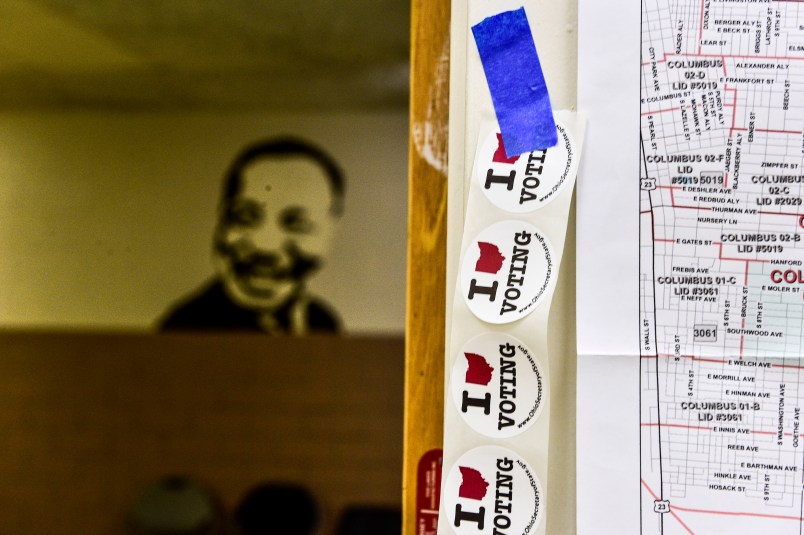COLUMBUS, Ohio (AP) — Ohio’s elections chief said Wednesday that more than 275,000 inactive Ohio voters are about to get their final opportunity to keep from dropping off the rolls.
Republican Secretary of State Jon Husted said that’s the total number of so-called “last chance mailings” going out from county boards of elections as part of Ohio’s contested process for keeping its list of eligible voters up-to-date.
Ohio’s procedure for maintaining its voter rolls is considered one of the most stringent in the nation, because it employs a “supplemental process” that has led to the removal of thousands of people based on their failure to vote in recent elections.
Civil rights groups unsuccessfully challenged Ohio’s regimen as a voter “purge” ahead of last year’s election — claiming it violated a provision of the voter registration law that prohibits rescinding someone’s registration “by reason of the person’s failure to vote.”
The U.S. Supreme Court rejected their arguments, finding in Husted’s favor. Nonetheless, he temporarily put the procedures on hold to avoid confusion during the November election, in which he was elected lieutenant governor.
Husted characterized last chance mailings as part of his office’s efforts to help voters stay registered — not to kick them off the rolls. Those efforts also include new online notifications for voters about changes to their registration status and the use of Bureau of Motor Vehicles data to confirm a voter’s address.
“From online voter registration to these last chance mailings, every innovative reform implemented by my office over the last eight years has been done to make it easier to vote and harder to cheat,” he said in a statement. “We want every eligible Ohioan to be an engaged, active participant in our elections.”
Spokesman Matt McClellan said those who respond properly to the last chance mailings will remain registered. And if they drop off, he said, they can easily re-register online .
Ohio’s voting rules are of particular interest nationally, because it’s one of the larger swing states with the potential to determine the outcome of presidential elections.
The state’s maintenance procedures stemmed from a requirement in federal law that states have to make an effort to keep their voter rolls in good shape by removing people who have moved or died. Husted’s office said most of the 275,000 voters receiving last chance notices have, in fact, probably either moved out of state or died.
Ohio secretaries of state of both parties have used voters’ inactivity to trigger the removal process since 1994.







Sure, because there’s sooooo much cheating by the voters themselves, as Kobach proved.
Riiiiiiiiiiiiiiiiiiiiiiiiiiiiiiiiiiiiiiiiiiiiiiiiiiiiiiiiiight!
Well, there’s something we can agree on. And as disgusting as the purge is, the people who can respond to the mailing or re-register to vote need to do that if they can. There is only one way for eligible voters to prevent more of this crap - register and then show up at the polls.
To be honest, this is the best way to go about it.
I’m not supporting the booting of these voters off the rolls. But if you aren’t where we think you are, in terms of the voter registration, then this is the right way to go.
A bit of history: Back in the day, when registration was still stored on index cards, my mom’s cousin was the Republican Registrar of Voters in his little town of some 6,000 citizens. Every year, he had to do a mailing of those registered to ensure they were still at their registered addresses - it was called a Canvass. If the card came back undeliverable, you were removed. If the card came back with the appropriate response, your registration was extended.
Connecticut now has Motor Voter. If you have a driver’s license, you can choose to let the DMV send notification to your local voting district that you live at this address in the district. Cousin used to complain, as they were transitioning to this process, that it was very confusing and a duplication of effort. But it worked and continues to this day.
I don’t have a problem with a canvass. None at all. You’re either there or you’re not. Hell, I have Christmas cards returned to me annually for people whose address has changed. Why not for voters?
We’re in the 21st century. When states can easily gerrymander with surgical precision based on the race and residence of every voter, a county can cross check voter registration with residential tax records.
I’m still trying to figure out why this is such a big deal? If there is no penalty for remaining in the voter rolls after one moves, and in some places I’ve read stories of people trying to un-register because they were moving and the county election board didn’t have a process to take them off the rolls. And I do believe it is not against the law to have died and still be on the voter rolls.
So why is this a hot button issue? If a person died or moved then I can see how it affects the participation rate within the county but what advantage does it give to have a perfectly clean voter roll? And if one is convicted of a crime, felony or not, how are they/who is suppose to notify the election board?